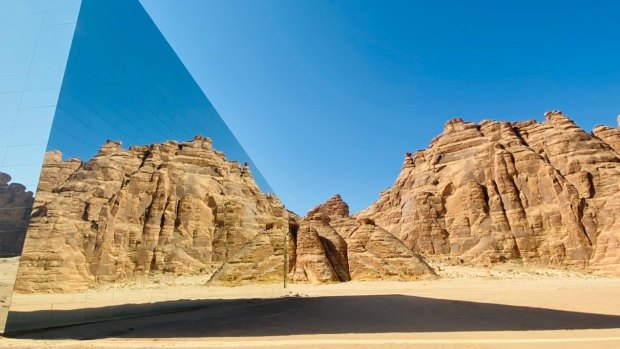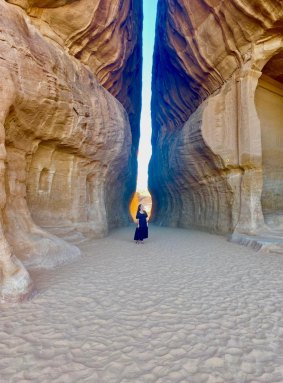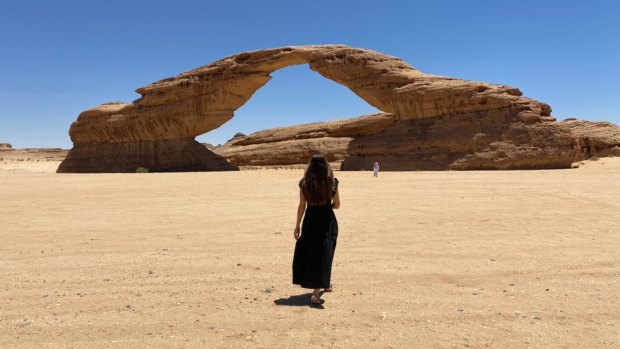This was published 2 years ago
AlUla, Saudi Arabia travel guide: Not your typical bucket-list destination
By Jane Knight

The spectacular mirrored Maraya Concert Hall.
It rises, mirage like, from the desert floor. Glimmering in the hazy heat before me is a giant cube, its sides mirroring the landscape's rust-coloured rock formations, carved by the wind over the centuries. Reality and reflections merge where the building's edges blur with its surroundings.
No, I'm not hallucinating, but gazing at the world's largest reflective building, the Maraya Concert Hall. Its whole 9740 square metres is covered with 3000 panes of tempered glass and it's seriously sparkling.
Built in 2019, this modern masterpiece couldn't be more of a contrast to the ancient architecture on show at the UNESCO World Heritage site of Hegra, a mere 20-minute drive away. It was here in the first century BC that the nomadic Nabateans carved ornate tombs from enormous rock structures, just as they did in Petra in Jordan. But while at Petra, tourists flock down a narrow rock cleft to reach the hidden city and are offered a camel or a mule to ride every few paces, here, our group is alone. It's just us, 111 tombs carved from boulders as big as buildings, and mile after mile of desert.

Exploring the UNESCO World Heritage site of Hegra.
This is neither your usual bucket-list site nor your average tourist destination. We are in the AlUla region of Saudi Arabia, 682 kilometres from Jeddah and 1000 kilometres from Riyadh. This is a country known more for its human rights abuses, treatment of women as second-class citizens, and no-alcohol policy rather than for opening its arms to travellers. Now, though, the kingdom built on oil wealth, is making a concerted effort to play catch up with other Middle Eastern destinations, aiming to attract an ambitious 100 million visitors by 2030.
It isn't somewhere this female journalist had previously been interested in venturing, but the prospect of seeing Saudi the easy way on a luxury cruise made it suddenly appealing; I would be able to enjoy all the comforts of life on board while making short, organised land forays to see the highlights.
Which is why I'm clutching a print-out of one of the new e-visas as I arrive at Jeddah airport with the first group of international passengers to sail from Saudi on a cruise since 2004, on board the uber-stylish Scenic Eclipse. The cruise port at Jeddah is so new, officials aren't quite sure how to deal with us, so going to and fro is a bit more bureaucratic than normal (though it's not as bad as the airports, where women are scanned separately in a private room). On board, it's different too, with a COVID-19 test taking the place of the usual glass of champagne to start the voyage. While ships are in port, you are quite literally in a dry dock.

Saudi Arabia is neither your usual bucket-list site nor your average tourist destination.
Before we can sip at sea, there is Jeddah's historic heart to explore. Here, 19th-century merchants enriched by the Asia to Europe trade route built imposing tower houses with large, intricately carved wooden windows protruding from the walls for better ventilation.
Many have seen better days; while they haven't quite gone to the dogs, they have certainly gone to the army of scrawny cats prowling around.
Others have been restored, including one owned by the wealthy Baeshen family with its three doorways - one for men, one for women, one for the office - leading to a flagstone-floored interior filled with memorabilia handed down through the ages. We explore the house opposite, too, with its upstairs living room for women, downstairs one for men. I'm only sorry we can't enter the Nasseef family house, which apparently has a specially built staircase to allow camels to carry the shopping to the well-ventilated kitchen on the top floor.
The searing heat means it's a relief to return to a cold towel, stylish cabins, and spacious interiors of Scenic Eclipse, where every crew member seems to know our names. An Indian tasting menu awaits in one of the handful of restaurants - and, joy, a drink!
Now the ship is sailing, there are plenty of places to try a tipple or two, including the whisky bar, where 110 bottles adorn the shelves. Amusingly, whenever we pull into port, each bottle is removed as part of a 20-minute process. Not so amusingly, any wine pairing in the restaurants on dock days is replaced by non-alcoholic drinks such as mango mules and espresso "martinis".
And so the bottles go up and down as we continue our Red Sea sojourn. It feels good to be back at sea, getting active in the gym and slothful in the spa, listening to talks, enjoying evening entertainment, and popping in at the bridge to chart our progress. There's no need to wear a mask on board this spoiling ship either, which takes just 228 passengers.
Although her twin helicopters can't be used in Saudi, Scenic Eclipse does have a variety of marine toys which we delight in using when we moor at the gleaming white strip of sand that is Marmar Island, inhabited only by green turtles and seabirds. Here, we dive to a depth of 20 metres in the onboard submarine (yes, really), gazing at shoals of fish nibbling the wall of coral before us, then snorkel on the surface before a spot of paddle boarding and kayaking.
We make another stop, too, at the port city of Yanbu, where the smiling, curious locals seem more interested in snapping pictures of us than we are of our surroundings: what feels like a Disneyfied version of a recreated historic town. While most of the women wear coverings over their heads and the full-length abaya, we do not have to conform; the only proviso is that we dress respectfully, keeping shoulders and knees covered.
I begin to see what Scenic CEO and owner Glen Moroney means when he says, "The difference between my expectation and reality was wider here than anywhere I have been before…There are huge changes in the country; they have the capital and the desire to change."
While Scenic Eclipse won't be returning to these waters for a few years, when she sails to Antarctica in January and then to Europe, she will pass the baton to her sister company's new Emerald Azzurra. Less opulent than Scenic, the new 110-metre ship will nevertheless offer a private yacht experience, with capacity for just 100 passengers on board. What's more, Emerald Azzurra's voyages will incorporate not just Saudi Arabia, but also Egypt and Jordan, with excursions to the pyramids of Giza and to the ancient city of Petra along with its Nabatean sidekick of Hegra in AlUla.
And believe me, Hegra is seriously impressive. It may not be on the same scale as Petra, but its tombs are in better condition, offering a different wow factor in the form of its massive monoliths rising from the desert floor. Probably the most iconic is the biggest tomb, standing alone in a sandstone outcrop 21 metres high, and belonging to Lihyan son of Kuza.
We follow Anwar, our female guide, to skirt the bottom of Jabal Al Banat, or Girls' Mountain, named because most of the 29 tombs were for women. She points out the beautiful carvings above the entrances, explaining that they show what a cosmopolitan bunch the trading Nabateans were: the five steps above the doorway symbolising the way to heaven show influences from Mesopotamia; the shelf cornicing from Egypt; and the head of Medusa against destroying the tomb from Greece.
I'm fascinated about the past, but also about the present in this mysterious kingdom. Did she have to ask permission from a male member of her family to take her job as a guide, I wonder? No, she laughs, a twinkle in her eye. "I'm adult enough not to have to ask anyone."
THE DETAILS
MORE
VISIT
Tourists must have an e-visa to enter Saudi Arabia which, together with obligatory medical insurance for COVID-19. See ivisa.com
A negative PCR test is needed within 72 hours of departure, visitors should have proof they are double vaccinated and must download the Tawakkalna app.
Despite its efforts to develop a tourism industry, Saudi Arabia remains a profoundly strict society. Both men and women should dress conservatively.
CRUISE
A 12-day voyage on Emerald Azzurra including stops in Saudi Arabia, Jordan and Egypt, and transiting the Suez Canal, costs from $10,563 a person with flights leaving Sydney for Jeddah on March 17 and returning from Athens on March 29, with free premium drinks packages for bookings made before November 30.
STAY
Flights should arrive in Jeddah before 2pm. For a pre-voyage stay, try the Jeddah Hilton, which has comfortable rooms from $680.
See hilton.com
Jane Knight travelled as a guest of Scenic, Cruise Saudi and Saudia.
FIVE MORE PLACES TO SEE IN SAUDI ARABIA
ALULA OLD TOWN
Stroll through the labyrinthine streets of this medieval mud-brick town, with 900 houses enclosed within its city walls. The last resident left here as recently as 1984.
See experiencealula.com.
JEDDAH WATERFRONT
Watch King Fahd's Fountain spurt water at 350 kmh to a height of 312 metres just off Jeddah's corniche, where you will also find an open-air sculpture museum with works by Joán Miro and Henry Moore.
DUBA
Known locally as the Pearl of the Red Sea, the little town of Duba is home to the King Abdul Aziz Fort, built in 1933 with mud-brick walls, as well as a bustling seafood market and some lovely nearby beaches.
AL WAJH
The almost abandoned old town at Al Wajh is the place for an atmospheric amble, taking in the historic 19th-century castle. Be sure to check out the rock that is shaped like a camel opposite the Saudi Electricity Company power plant.
ALULA FROM THE AIR
Get a birds-eye view of Elephant Rock, a sandstone monolith climbing three storeys into the Saudi Arabian sky, on a 30-minute helicopter flight. The experience, which costs 750 SAR ($269), also includes views of the ancient city of Hegra and other landmarks in AlUla, including Dadan, the old capital of the Dadan and Lihyan kingdoms. See experiencealula.com
Sign up for the Traveller Deals newsletter
Get exclusive travel deals delivered straight to your inbox. Sign up now.